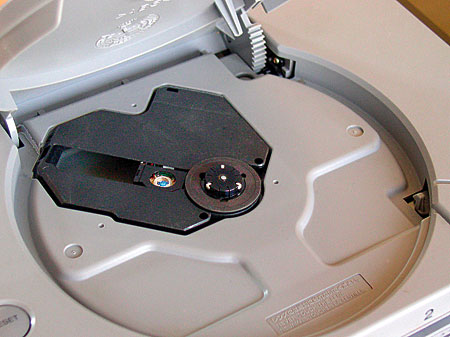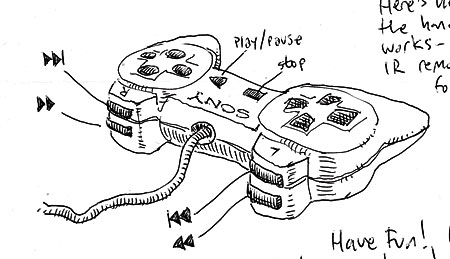| Columns Retired Columns & Blogs |
Does the PS2 or PS2 slim make as good a CD player?
Installation and Setup
In sending the PS1's line-level output to my Shindo Masseto preamplifier, I used both of the connection schemes described above, and wound up vastly preferring the sound from the Sony's RCA output jacks. By comparison, the sound from its A/V jack was bright and gritty.

Those distinctions may have arisen from differences in circuitry between the two schemes—or they may have come down to nothing more unfathomable than cable quality (footnote 2). Again, use of the A/V output jack required use of Sony's special cable—which might not be very special at all—while the RCA jacks allowed me to use whatever cable I wished. Unless and until I construct a custom A/V cable using Audio Note AN-vx pure-silver Litz wire, there's no way to tell for sure.
During my first round of comparisons of the two output schemes, I wondered if the absolute phase of the RCA output was the reverse of the A/V output's. But the extreme smoothness of the PS1's sound in RCA mode (see below) confounded my efforts at a detailed back-and-forth comparison, and the whole matter ultimately proved too fiddly to hold my attention for long.
Three Ayre Myrtle Block isolation feet, placed between the bottom of the very lightweight PS1 and its surroundings, had no apparent effect on its performance.
Listening
When I first tried playing music on the little gray PlayStation 1, it didn't respond to the Play button on its handset. Out of quiet desperation, I pressed the Reset button on the left side of the player, and immediately heard a succession of two deep notes from a digital synthesizer: the sort of thing I'd expect during the opening moments of a DVD, with a logo for the studio's home-video division displayed on the screen. (Given that the CD in the transport was a collection of field recordings titled The North Carolina Banjo Collection, I was mildly surprised.) I also noticed that the PS1's output level seemed considerably lower than I'd expected.
The PS1's sound was unique in a number of ways. First, its frequency response was just a bit down at both frequency extremes, yet its slightly diminished bass content and rolled-off treble were apparent only in direct comparison with other players. While I can't imagine that the audio-only performance of such a product would have been tweaked so carefully, the end impression was of a cannily tailored frequency range—that, and an exceptionally smooth sound, with no edginess or artificial grain whatsoever.

Second, and despite the relative lack of treble extension, the PS1's midrange was remarkably clean, present, and tactile. On Tony Williamson's "Boatman," from Still Light of the Evening (CD, Mapleshade 08952), the guitar fills and G-runs were notably more audible, more nuanced, and more impactful through the PS1 than through Sony's own SCD-777ES SACD/CD player. Amazing.
Those qualities extended to singing voices, and with virtually every disc of vocal music I tried. Bidu Sayao's delicate soprano on Villa-Lobos's Bachiana Brasileira No.5, recorded in New York in 1945 (CD, Sony Classical MHK 62355), crossed oceans of time: She was there. Levon Helm's equally wonderful voice on "Little Birds," from his recent Dirt Farmer (CD, Vanguard 79844-2), was simply believable, and astoundingly present—appreciably more so than with the SCD-777ES.
The Levon Helm album also allowed the PS1 to show off its fine sense of touch and impact: Not only was the sense of force behind Helm's drumming preserved through the cheap Sony player, but the mandolin and violin players seemed to dig in a little more when heard through the PS1. And throughout You Were There for Me, by Peter Rowan and Tony Rice (CD, Rounder 11661-0441-2), Bryn Bright's upright bass and, especially, Larry Atamanuik's subtle, distantly miked percussion were very impactful—again, markedly more so than with the more expensive deck.
Above all, with every CD I tried, the PS1 exhibited a superior level of rhythmic acuity, or—since it's true that an amplifier or CD player can't make recorded music sound faster or more propulsive than it actually is—a superior lack of the distortions that can blunt leading-edge transients and make music sound temporally dull and listless. Even slow, broadly paced music sounded involving through the PS1: the best and truest praise I could give it.
A final performance note: Whenever the program material on a given CD finished playing, the Sony PS1 didn't stop the disc but carried on playing it, beginning again with track 1. The CD player in my car does that, too.
Conclusions
I expected one of those hip affordable products that sounds a little edgy or a little tinny, but gets the notes and beats really right. The truth was different. Sony's PlayStation 1 offered some of the least edgy, least tinny digital sound I've heard. And got the notes and beats really right.
Compared with the kind of performance I'm used to hearing from high-end CD players, the PS1 had a very un–hi-fi sound. Whether you think that's a good thing or a bad thing will depend on your point of view. If certain other audio reviewers are right, it may even have to do with the time of day when you were born.
I think it's a good thing. So does my wife, who thought the PS1 was consistently more engaging than any other digital player she's heard in a long time. If John DeVore doesn't mind, we're going to write him a check—the cost of shipping the player was about three times the cost of buying it—and we'll keep this PS1 for ourselves. (John has more.)
Partly because of my indifference to digitally mastered music, I admit to having less experience with cutting-edge CD players than do most of my colleagues. That said, if I owned any of a number of other digital source components, and if my daughter owned a PlayStation 1, I would offer her a trade—although I don't know what possible use she could have for the former, and I don't know if I could shake the guilt that comes from getting the better part of the deal. Perhaps if certain "high-end" CD players came bundled with a few games...?

Does the PS2 or PS2 slim make as good a CD player?